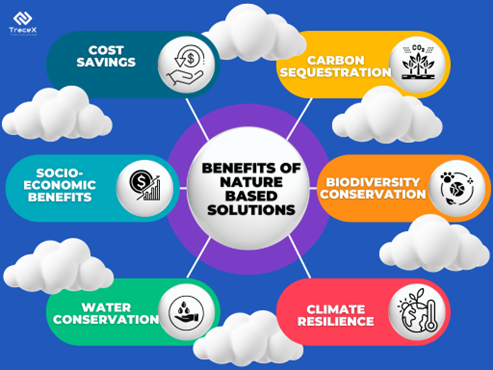Contact: +91 99725 24322 |
Menu
Menu

The world today is increasingly challenged by climate change and the pressure is on to find sustainable ways to restore our environment while maintaining economic growth. Nature-Based Solutions (NBS) is an approach that uses nature to tackle some of the biggest environmental challenges we face, from reducing carbon footprints to enhancing biodiversity. From restoring mangroves to improving soil health through regenerative agriculture, nature-based solutions hold the promise of a greener future.
Climate crisis has increased 40% over the last 20 years and most of the people globally are bearing the brunt of the climate and nature crisis.
Many businesses struggle to implement these solutions effectively, facing challenges such as high upfront costs, uncertain ROI, and a lack of clear frameworks for measuring impact. Without the right guidance, these solutions can seem out of reach. That’s where this guide comes in—providing you with actionable insights and a clear path to making nature work for your sustainability goals.
Key Takeaways
Humans are the main cause of climate change. We burn fossil fuels, chop down trees, causing global warming, thereby disrupting the entire ecosystem. A warmer world even by half a degree can put agriculture, water supply and health at risk. The shift in temperatures are not just thresholds, every rise in warming is detrimental to the planet. The overall ambition to reduce greenhouse gas emissions is inadequate. Even if the pledges and plans to cut emissions go as per schedule, global emissions will still keep growing under the present trends. It is not too late to slow the pace of climate change and avert the impacts. We need to act today or else the window of opportunity to keep the temperatures within limits will be shut totally.
We need to deal with climate change as it is a key to ensuring sustainable development and safeguarding economic growth. Inaction will be costlier than acting now. Emission reductions are required to keep global temperatures from increasing and reducing its impacts and moving towards a climate-resilient path. Let us not forget that half of the world’s GDP depends on sectors of agriculture, forestry and fisheries and hence needs sustainable use of resources.
Every fraction of a degree matters and what we do between now and 2030 will determine whether we can slow global warming to avoid the worst impacts.
According to IPCC, managed and natural terrestrial ecosystems absorb one-third of anthropogenic CO2 emissions. Nature can help in mitigation and adapting to the worst effects of climate change and play an important role in meeting the goals of Paris agreement.
According to UNEP report, humanity is using about 1.6 times the number of services that nature can provide sustainably.
Conservation alone will not help in preventing the collapse of the ecosystem. Nature based solutions are an opportunity to address these problems. Storage of carbon, ensuring food and water and protecting against impacts of global warming can assure a nature positive future.
Nature based solutions are a set of activities that harness the power of nature to protect and restore ecosystems while safeguarding the wellbeing of mankind and biodiversity. Switching to agriculture practices like crop rotation, no-tillage that support healthy soils, restoring coastal wetlands, regrowing of forests help in capturing carbon from the atmosphere and sequestering it in plants and soils. They provide cleaner air and water and increased biodiversity. Combined with innovations in clean energy and other decarbonization efforts, nature-based solutions can offer good solutions in the response to climate change.
Do you know that Nature based solutions can provide up to 37% of emission reductions needed by 2030 to keep the global temperature rise under 2˚C?
The idea behind nature-based solutions are that when ecosystems are healthy and well managed, they help in reducing GHG emissions, provide clean air and water and increased food security. They are a win-win for both people and nature.
The rise of carbon and other greenhouse gases in the atmosphere is not solely contributed to energy, industrial and agriculture activities. It is also linked to degradation of carbon-rich soils and terrestrial ecosystems.
IPCC estimates that approximately 13% of human caused emissions result from deforestation and changes in land-use.
This loss of nature not only contributes to greater carbon buildup in the atmosphere but also diminishes the capacity of natural systems to absorb atmospheric carbon.
Given this impact, the role of nature becomes important in climate mitigation approaches. Safeguarding, reviving and augmenting ecosystems enhance the ability to extract carbon from the atmosphere which is critical for effective climate mitigation strategies.
According to the Exponential Roadmap for Natural Climate Solutions, to meet climate goals we need to restore 350 million hectares, protect 45 million hectares of forests and wetlands, and adopt more sustainable practices in at least two billion hectares of working land.
Reforestation and afforestation are two critical approaches in the fight against climate change and environmental degradation. Reforestation involves planting trees in areas that have lost their forest cover due to deforestation, wildfires, or other disturbances. It helps restore ecosystems, improves biodiversity, and sequesters carbon dioxide from the atmosphere. Afforestation, on the other hand, is the process of creating new forests in areas where no forests previously existed. This practice not only increases tree cover but also enhances soil health, prevents erosion, and creates new habitats for wildlife. Both reforestation and afforestation play a vital role in mitigating climate change, as they act as natural carbon sinks, absorbing carbon dioxide and releasing oxygen. By investing in reforestation and afforestation, we can help combat global warming, improve air and water quality, and create a more sustainable future for our planet.
Forests are the best examples of nature-based solutions. Forests house 80 % of world’s biodiversity and provide clean air and water and protect against erosion and landslides. Forest carbon projects regulate the climate by absorbing carbon from the atmosphere. The Amazon forests are large reservoirs of carbon sequestering huge amounts of carbon in tree biomass and soils. Deforestation and degradation contribute to 13 % of global carbon emissions and we can significantly reduce this warding off the worst impacts of global warming.
Tree planting is a vital nature-based solution for carbon sequestration which involves the process of capturing and storing carbon dioxide from the atmosphere in trees and vegetation.
Restoring degraded ecosystem involves reviving ecosystems that have been damaged or degraded due to human activities such as deforestation, mining , agriculture or urbanization.
Enhanced Carbon Sequestration- Restoring degraded lands through reforestation/afforestation increases carbon sequestration. New vegetation captures and stores carbon, helping to offset emissions.
Regenerative agriculture practices like cover crops, crop rotation, no-tillage help in soil restoration and regeneration of tree and vegetation. This helps in preventing soil erosion and also in helping to absorb more emissions. Climate smart agriculture enables farmers to retain carbon during crop production. This also includes agroforestry and livestock management.
Agroforestry, an ancient land practice has gained modern relevance as a nature-based solution to meeting the ecosystems and livelihoods demands. The practice offers multiple ecosystem benefits by integrating trees with crop and pasture lands in different spatial and temporal arrangements. Agroforestry mixes trees with other agriculture land-use like field crops and livestock. Nurturing existing shade trees and planting new ones amidst crops can increase carbon storage and create a protective canopy to regulate temperature and humidity.
Many coastal and marine habitats including mangroves, seagrass and saltmarshes are rich in carbon and have high rates of carbon sequestration.
Mangrove forests sequester carbon 2 to 4x faster than mature tropical forests.
About 67% of mangrove, 35% of saltmarshes and 29% of seagrass meadows have already been lost. It is critical that these carbon stores are protected. Restoration of coastal and marine ecosystems can sequester large amounts of carbon.
Mangrove Forests along coastlines are protective barriers against soil erosion and storms and are important for sustainable fishing.
They filter water, provide food resources and timber to the coastal communities. Conserving and restoring these ecosystems increase the climate resilience and help in protecting people and the planet. These are the wetland related practices that focus on conserving and restoring peatlands and coastal wetlands.
Peatlands play a crucial role as remarkably efficient carbon sinks. The absence of oxygen under anoxic conditions prevents decomposition of organic matter effectively locking away carbon for long periods. Despite covering only 3% of earth’s land area, peatlands hold a 21% of global soil organic carbon. However, 10% of peatlands have fallen victim to degradation due to drainage or mining, causing them to release the stored carbon. Restoring wetlands through rewetting transforms carbon sources back to carbon sinks presenting a sound strategy for mitigating climate change. This not only aids biodiversity but also offers potential for sustainable income through peatland agriculture.

Biodiversity Conservation plays a pivotal role in maintaining the resilience of ecosystems, ensuring the ability to withstand disturbances and adapt to changing conditions. Safeguarding diverse plant and animal species helps to maintain intricate balance of ecosystems.
NBS enhances ecosystem services by promoting the restoration and preservation of biodiversity. As these ecosystems thrive, their capacity to provide clean air, water, pollination and climate regulation gets strengthened. This benefits both the environment and human livelihoods.
Prioritizing biodiversity conservation with NBS initiatives fosters ecosystem resilience and contributes to the survival of endangered species which form an integral component of a sustainable and interconnected planet.
Nature-based solutions for carbon offsets involve leveraging natural processes to capture and store carbon dioxide, offering a sustainable way to address climate change. These ecosystems act as natural carbon sinks, absorbing CO2 from the atmosphere and storing it in biomass and soil. By protecting, restoring, or expanding these natural areas, we can reduce greenhouse gas concentrations and help offset carbon emissions from industrial activities. Nature-based solutions are often more cost-effective compared to technological alternatives and provide additional benefits like enhancing biodiversity, improving water quality, and supporting local communities. As businesses and governments aim for net-zero targets, integrating nature-based carbon offset projects becomes a key strategy for achieving climate resilience and sustainable development goals.
Quantifying the effectiveness of carbon capture through NBS involves assessing the amount of carbon stored in ecosystems over time. Monitoring, Reporting and Verification (MRV) systems accurately measure and assess the amount of carbon sequestered by various natural ecosystems. DMRV systems play a critical role in tracking the effectiveness of NBS initiatives and ensuring their contribution to carbon mitigation goals.
MRV systems use a combination of data collection methods such as satellite imagery, ground-based measurements and modelling techniques to monitor carbon stocks over time. MRV systems provide transparency and accountability ensuring that the benefits of NBS projects are backed by credible data. Robust MRV systems enable aggregation of carbon capture data on a large scale contributing to global efforts to address climate change through nature-based solutions
The TraceX Digital Measurement, Reporting, and Verification (DMRV) platform is designed to assist project developers in overcoming key challenges associated with nature-based solution (NBS) carbon projects.
In conclusion, nature-based solutions (NbS) represent a vital approach to mitigating climate change while enhancing biodiversity and supporting sustainable development. By leveraging the natural ecosystem’s capacity to sequester carbon, manage water resources, and promote resilience against climate impacts, we can create a more sustainable and equitable future. Collaborative efforts among governments, businesses, and local communities are essential for implementing NbS effectively. Embracing these solutions not only addresses the pressing challenges of climate change but also fosters a healthier planet for future generations.
Nature-based solutions (NbS) are strategies that utilize natural processes and ecosystems to address environmental challenges, particularly climate change. These solutions involve restoring, protecting, and sustainably managing ecosystems, such as forests, wetlands, and grasslands, to sequester carbon, enhance biodiversity, and improve resilience to climate impacts. Examples include reforestation, wetland restoration, and sustainable agricultural practices.
Nature-based solutions enhance climate resilience by improving ecosystems’ ability to withstand and adapt to climate change impacts. Healthy ecosystems, such as wetlands and forests, provide natural buffers against extreme weather events, regulate water cycles, and protect against soil erosion. By investing in NbS, communities can reduce vulnerability to climate-related risks while simultaneously benefiting from the ecosystem services these environments provide.
Yes, nature-based solutions can complement technological solutions for climate change mitigation. While NbS focus on leveraging natural ecosystems, technological solutions, such as renewable energy and carbon capture technologies, can work together with NbS to create a holistic approach to climate action. Integrating both strategies can enhance overall effectiveness, providing multiple pathways to reduce greenhouse gas emissions and increase climate resilience.



WhatsApp us